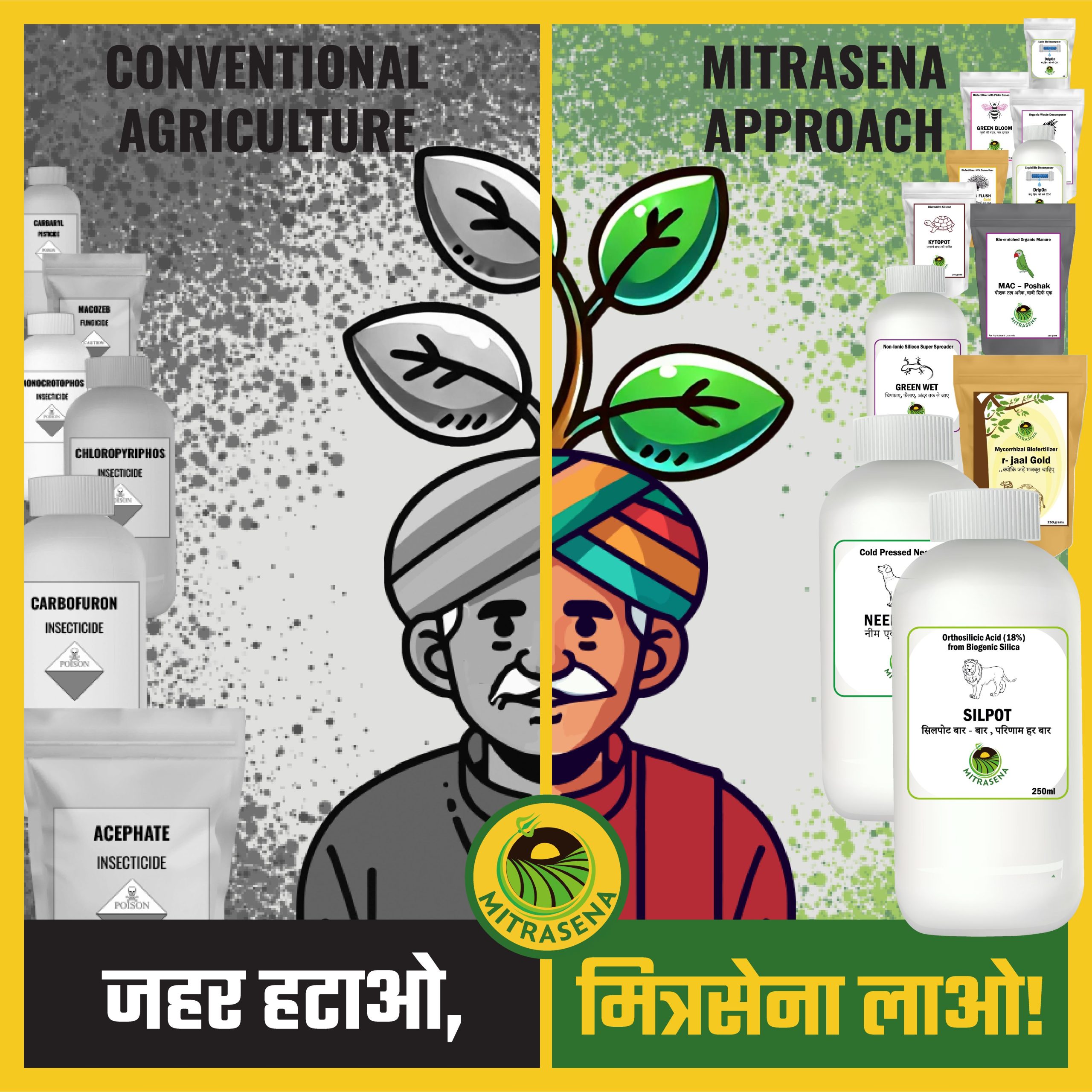
Mitrasena approach brings a different outlook to farming. Farmers and stake holders engaged in conventional agriculture has various queries in mind. The questions range from cost dynamics, to efficacy, to productivity and after all the farmer profitability.
Apprehensions are natural with the so-called audacious claim of offering “seamless transition” to “non-toxic farming” with “better productivity & profitability”. This is well reflected in Mitrasena tag line “Fasal Bachaye, Kamai Badhaye. Jahar Hataye, Saral Upay”.
This article touches upon various aspect and offers a comparative understanding of Mitrasena vis a vis conventional agriculture.
| Conventional Agriculture | Mitrasena Approach |
| Nutrition Management | |
| Total reliance on nutrient supply through Fertilizers. Includes primary nutrient N,P,K. Secondary nutrient Ca, Mg, S. Micro-nutrients Fe, Zn, Bo, Mn, Mo, Cu, Cl.Limited reliance on Silica (Si). | Recommends Fertilizers along with Microbials in soil for better availability. Long term gradual reduction in Nitrogen Fertilizer and shifting it to fixing from atmosphere. Considers Silica (Si) as a secondary nutrient along with Ca, Mg, S. |
| Pest & Disease Management | |
| Believes in Killing the Pests & Pathogens for protection. Totally reactive approach in response to the pest attack or disease attack. Quite complex to always identify the problem and mitigating it. Another approach is through genetically modified varieties like BT Cotton, BT Brinjal etc. Struggles with the challenge of pest becoming resistant to old molecule. Continuous challenge of changing the solution. Practically not able to tackle new pests & diseases. Has to rely on other IPM strategies for many problems like fruit fly, borers etc. | Build on “Plant Empowerment” and “Soil Improvement” as the primary defence with strong reliance on Silica, Biopolymer & Microbials along with balanced nutrition. Supported with Neem Oil and Pheromone Traps & Lures. Silent on seed type and works on all types of seeds – conventional, hybrid or genetically modified. Approach is not on killing and hence there is no issue of resistance development. Since works on plant health & soil, it is far better prepared to respond to pests & diseases. For some of the problems relies on conventional pesticides. |
| Soil Improvement | |
| Limited solution offered. | Integral to the core philosophy with beneficial microbes and mycorrhiza. Focuses on Improvement in photosynthesis for higher carbon absorption and fixation in soil. |
| Climate Resilience | |
| No strategy except for going for controlled environment farming or development of more robust variants. | Strong focus on making plants mitigate climate extremes. Focuses on robust cell structure with silica, deep & wide roots with mycorrhiza, better aeration and soil biology etc.. Improves survival chances in extreme heat, water deficiency, excess rain, excess cold, cloudy days etc. |
| Weed Management | |
| High dependency on weedicide. | Recommends gradual reduction in weedicide usage. Reliance on good composting, on farm composting to reduce weed load. |
| Cost & Efforts | |
| Requires specific problem identification and remedy thereof. Dynamic identification and treatment make the whole approach complex. Farm activity & labour management becomes complex. Variable cost as it is reactive in approach. No clear definition of cost. Real life experience of cost is more than theoretical cost explained. For example, in most vegetables, farmers end up spraying one pesticide or the other every 5-7 days. | A defined protocol with regular supplement. Preventive approach makes it simple to use. Only few products which are simple to use. Easier to plan farm activity & labour management due to defined schedule. Defined cost as it is proactive in approach. Upfront definition of cost. Real field experience says that the cost is same or lower than conventional practices. For example, in vegetables, Mitrasena recommends some spray every 5-7 days. |
| Productivity & Profitability | |
| Productivity & Profitability is average as can be seen from the farmer stress. | 10-25% higher production due to better crop health.5-15% higher rates due to superior quality producePotential for higher premium with residue free produce.15 – 50% more profit per Acre is estimated in most cases. |
There was this interesting discussion I had with Mr Prateek
The teaser of Self Running Soil Revolution for an investment
The effectiveness of any microbial product depends not just on
Mitrasena (Army of friends) is global brand of Biowall Agrihealth Pvt Ltd. Mitrasena products & protocols enables seamless transition to non-toxic farming by concurrently offering Excellent Protection, Higher Productivity & Profit and, Ease of use.
We are a DIPP recognized Startup working for non-toxic crop protection. We are driven by a highly passionate and professionally competent team.
MitraSena © 2025 | All rights reserved | Innovatively Designed and Built by Social Mukul Media
Have any query about bulk orders? Get in touch with us.